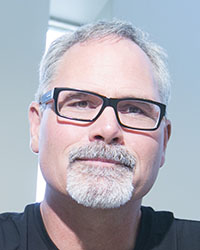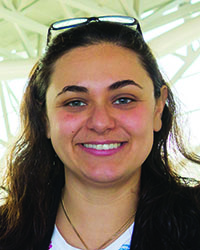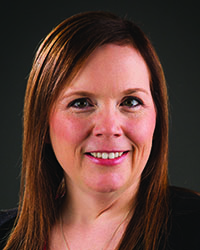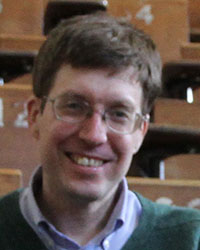Healthy tech ventures
From Saskatchewan to around the world, U of S graduates and researchers are changing the face of health with technology.
By Kathy FitzpatrickA surgeon leads a patient on a virtual reality tour inside the patient's brain- in preparation for removing a tumour. A teenager with Crohn's disease receives prompts on his smartphone to get his bloodwork done. Lab-grown cartilage and heart tissue make joint replacements and heart transplants a thing of the past.
These are some of the ways researchers at or from the U of S hope to use technology to create game-changing advances in health care.
Back to reality

It's like stpping inside a 3D movie. And it's this quality of the technology that makes Cory (BA'90, MA'94) believe it could have useful applications in health care, such as teaching medical students brain anatomy.
"The power of it is that we live in an environment that is inherently spatial... when you put the VR headset on it feels natural, it feels very intuitive," said Cory, CEO of the Saskatoon-based technology company Sprockety.
After demonstrating VR technology to Dr. Ivar Mendex, Fred H. Wigmore Professor and unified head of the Department of Surgery at the U of S, Mendez asked Sprockety to produce a VR brain.
Cory shows me that, too. With the hand controls, I can turn the VR brain and look at it from every angle. I click on different parts and the names appear. The big red mass is a tumour. Another click and I can even look at the tumour from the inside, see yellow strands threading through it.
Ali Jamal, now a third-year medical student, ran the study to test the VR brain’s effectiveness as a teaching tool. He found students using it scored better overall on long-term retention than those using a textbook.
Jamal suggests a possible explanation: in real life, it’s hard to tell one part of the brain from another by look or colour but virtual reality may help overcome that hurdle.
“So, you’re learning spatial orientation of 3D structures that you can’t necessarily tell apart just by looking with the naked eye,” Jamal explained. “I think that’s where virtual reality is helpful. You are able to see the delineations within virtual reality that you weren’t necessarily able to see in real life.”
(And perhaps with greater difficulty in two-dimensional images and 3D plastic models.)
Over the next year, Sprockety plans to work with Mendez on a series of VR brain modules for teaching medical students and residents about various brain structures and pathways, and educating patients with brain tumours about their medical situations.
They believe one day it may also be possible for surgeons to plan an operation using virtual reality, perhaps even perform a dry run, to avert mistakes with potentially devastating consequences.
Mobile health

Smartphones have become so ubiquitous and so loaded with features, it’s no surprise that researchers have latched on to them as revolutionary tools in health care.
Dr. Farrah Mateen (MD ’05) has confirmed their usefulness in testing for epilepsy in patients living far away from the standard equipment and expertise, with little or no means to access it.
Now a neurologist at Massachusetts General Hospital and Harvard Medical School, Mateen is leading research on the use of Android devices to conduct EEGs in some of the most remote and poverty-stricken parts of the world. (EEG, or electroencephalography, tracks and records brain wave patterns.)
Mateen estimates more than 80 countries worldwide don’t have EEG, and in many others, it’s only available in the capital cities.
“We’re trying to use technological innovation for neurological care, bring neurology out of the dark ages in terms of mobile health,” she explained.
Mateen launched the project in 2013, testing a newly-developed smartphone-based EEG with about 200 patients in Bhutan, a tiny country on the eastern edge of the Himalayas. People would walk for several days to be in the study, she said.
Up to one per cent of the population, or about 10,000 people, in Bhutan may have epilepsy, Mateen explained, adding that infection with tapeworms from contaminated water and undercooked pork may be a factor. Larval cysts in the brain can trigger epileptic seizures.
Affordable medication has been available for a long time, but the problem is linking patients to it, she said, through appropriate diagnostic testing.
Smartphone EEGs offer a low-cost solution. A health-care worker can run the test. A cap with electrodes is wirelessly connected to the app on a smartphone or tablet. Recordings can then be sent to neurologists anywhere in the world for interpretation. The equipment cost runs about $300 USD, compared with $20,000- 30,000 for the standard EEG, Mateen said. And she points out, the smartphone EEG is portable and does not require electricity.
In April this year, she and her colleagues published their findings in the journal Scientific Reports. They concluded that smartphone EEGs yield very specific but less sensitive results than regular EEGs, making the smartphone version better for confirming suspected cases of epilepsy than as a screening device.
Mateen is expanding her research to West Africa, beginning in Guinea where she has seen about 140 patients as of mid-July.
Patient empowerment

At the U of S the College of Nursing, assistant professor Tracie Risling (BA'98, BSN’03, MN'07, PhD'14) sees digital technology as the fast lane to patient empowerment and engagement.
“We are used to living in a society and an age where information is at your fingertips,” Risling observed.
In an era when parents can use smartphones to transfer their kids’ allowance to them, teachers can upload their students’ grades, and everyone can get an up-to-the-minute weather forecast, patients are demanding digital access to their own health records, Risling said.
“Technology is going to be a means to truly deliver on this long-held promise of patient-centred care.”
Risling worked on a six-month pilot project last year with the province’s electronic health records system eHealth Saskatchewan. Citizen Health Information Portal (CHIP) gave 1,100 patients secure access to their own electronic health records: lab results, vaccines and immunizations, prescriptions, and hospital and acute care visits. The patients were also able to add personal health information, set reminders to take medications and record upcoming appointments. Their physicians were able to see what patients added to their profiles.
The information put one patient literally on the same page as her doctor when a bloodwork anomaly led to a cancer diagnosis and surgery. The patient saw the test result and raised it with her doctor. Risling said the doctor was already planning to discuss it with the patient and “they met in the middle.”
“When she talked to me that evening prior to her surgery, she was still feeling like she was in control of that situation. And she was leading that whole process because she had the information,” Risling recalled.
Herself the mother of a teen with Crohn’s, Risling is also working on the use of smartphones and social media to help teens with inflammatory bowel disease take the lead in their own care. Dual messages go out to both caregivers and the teen. The more times the young person said “yeah I got my bloodwork done, yeah I filled my prescription,” the fewer messages go to the caregiver.
Risling is also putting tablets into the hands of parents with children in hospital, enabling them to see pictures of their care team and their child’s vital statistics for the day. Parents can also post three top things staff can do to comfort their child when the parents aren’t there, and what not to do.
Intuitively, it seems clear that access to their own health records with the click of button gives patients greater control in their medical journey. But how to prove it? That’s the next step for Risling and her collaborators, using computers to create a scientificHand-held research labs

Over in the Department of Computer Science, what began as a smartphone app has morphed into an enterprise that is taking health-care research in directions hard to imagine a decade ago.
About eight years ago, associate professors Nathaniel Osgood and Kevin Stanley began work on a sensor device to track the movement of study participants, useful data for predicting health risks such as how flu viruses may spread. The project developed into the iEpi smartphone app.
They realized that mobile devices “can be formidable for not only measuring what (people are) doing at a given time, but also for asking them questions and for getting them to volunteer information, let’s say when they’re taking some medication … or feeling ill … or if they’ve just encountered an advertisement about tobacco or what have you,” Osgood said.
The app collects information from sensors built into the smartphones, along with information volunteered through questionnaires, photographs, even sound and video recordings. It can be linked with wearable devices such as Fitbit and other smartwatches to measure heart rate and electrodermal response, an indicator of stress or arousal.
It is a micro research lab that enables the collection of an unprecedented level of data, both in volume and detail. For instance, when a study participant takes a photo of a tobacco billboard, researchers will know where it is, what time the person came across it and if they smoked afterwards.
Before long, Osgood and Stanley were approached by researchers wanting to use the app in some very large studies, with tens or hundreds of thousands of participants. So, last year with help from the Innovation Enterprise office at the U of S (formerly the Industry Liaison Office), they formed a start-up called Ethica Data.
The company collects data from smartphones (either Androids or iPhones), aggregates it, streams it to servers, and allows both study administrators and subjects to browse their own data.
“What we’ve designed is a robust, easy-to-use, flexible, powerful and integrated system,” Osgood explained.
Notably, it enables health researchers to very quickly and easily launch a new study without the need for custom programming and the help of computer scientists, Osgood said. Think of on-the-spot research into sudden public health crises such as food contamination or disease outbreaks.
But the system is also valuable in researching such intractable problems as tobacco addiction or the high rate of suicide in northern communities. Or, studies to answer such questions as whether e-cigarettes help break nicotine addiction or act as a gateway.
Another key feature: the capacity to not only obtain informed consent from study participants online, but also to enable them to suspend data collection at any time, even delete their data retroactively.
Osgood maintains this does not jeopardize the validity of a study, because in practice very few people exercise this option. And yet it’s important, particularly to disadvantaged people, who may be anxious about providing personal information.
And in a kind of spy vs. spy scenario, Ethica can also capture the internet browsing patterns of study participants (with their consent). For instance, when they click on links with tobacco-related words researchers can learn about the advertising they see. Osgood said corporate interests are also mining data from online behaviour and using it to promote their products.
“And by providing the option of people to join studies like this we provide an avenue for us to counter that effectively and in a very flexible way,” he explained.
Osgood and others, including various public health agencies, are now looking at creating an ongoing pool of respondents they can tap into for studies from time to time, a kind of population observatory or sentinel group comprising perhaps five per cent of the population. This proverbial canary in the coal mine can provide an early warning of threats, and allow for both quick responses in an emergency and better decision-making overall, Osgood said.
Perhaps some data will be held in escrow, he goes on, to be retroactively mined for retrospective analysis.
And, using big data or machine learning techniques, we may one day see the creation of digital nudges that prompt people to, say, dial up the tobacco quit line when they pick up a cigarette.
“I think here we have a wide-open set of possibilities and it’s a privilege to be at the forefront of this,” Osgood said.
Internal engineering

Meanwhile, the College of Engineering is discovering solutions for problems as varied as weakened hearts and worn out joints.
For the past decade, Daniel Chen (PhD'02), a professor of mechanical and biomedical engineering at the U of S, has led the Tissue Engineering Research Group, a collaboration between engineering and life sciences researchers. Their quest is to find ways to grow various types of human tissue that can be implanted in patients to repair or replace damaged body parts.
Three-dimensional scaffolds are fabricated with a 3D printer, using biodegradable and biocompatible materials that can support living cells. Patients’ cells are then seeded onto the scaffold so tissue for implantation can grow.
It may sound simple, Chen said, but it requires a lot of research on how to design and fabricate the scaffolds, how to implant the living cells and make sure they grow into the desired tissue.
There has been progress. Since 2014, the focus has been on growing tissue to replace muscle damaged in heart attacks and damaged cartilage. Success could lessen or eliminate the need for donor heart transplants and artificial hearts and joints.
“That would be great. So, I’m really excited about this,” Chen said.
In lab mice and rats, the cardiac procedure has been tested by inducing heart attacks and then implanting the cell-laden scaffold (or patch as it’s also called).
So far it has worked well, Chen said. Next is testing on larger animals before moving on to human clinical trials, steps that will depend on the continued flow of research funds.
Similarly, he and his colleagues have been testing cartilage replacement on mice and rats, with work in that area also continuing.
But work is also proceeding on a way to make artificial joints last longer. Qiaoqin Yang, also a professor of mechanical engineering and Canada Research Chair in Nanoengineering Coating Technologies, is leading research on that path.
Success would have a significant impact. The number of Canadians undergoing hip and knee replacements has topped 100,000 in a single year. But like cartilage, artificial joints wear out too, lasting an average 15-20 years.
Yang is working on microscopically thin coatings, measured in nanometers—one billionth of a meter. (A sheet of paper is about 100,000 nanometers thick.) She is searching for a biocompatible nanocoating that will keep friction low, and increase wear and corrosion resistance.
She has developed a diamond-like carbon coating combined with nanoparticles, but so far, the major challenge has been to get this coating to adhere well to metals suitable as medical implants.
Yang has approached this challenge by designing different types of interlayers and surface treatments to enhance adhesion of the diamond-like material.
“From lab tests the adhesion has been significantly enhanced,” Yang said.
She has found the use of different kinds of nanoparticles has decreased stress, and hopes this will lead to the next step— measuring friction, wear and corrosion in an implant simulator. If the results are successful, human trials would follow.
Another concern is the possible release of toxic ions, which the coating is intended to prevent. That, too, will require testing.
Only time will tell how these technologies will exactly change the health-care landscape, but one thing is for certain: technology in the hands of U of S alumni and researchers is bound to improve patient outcomes.


